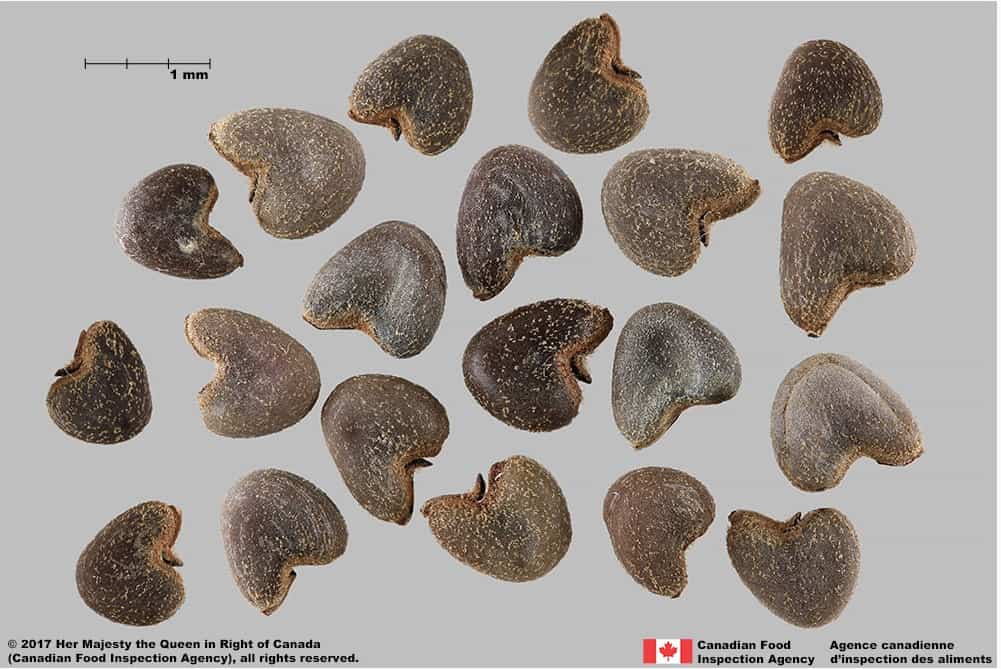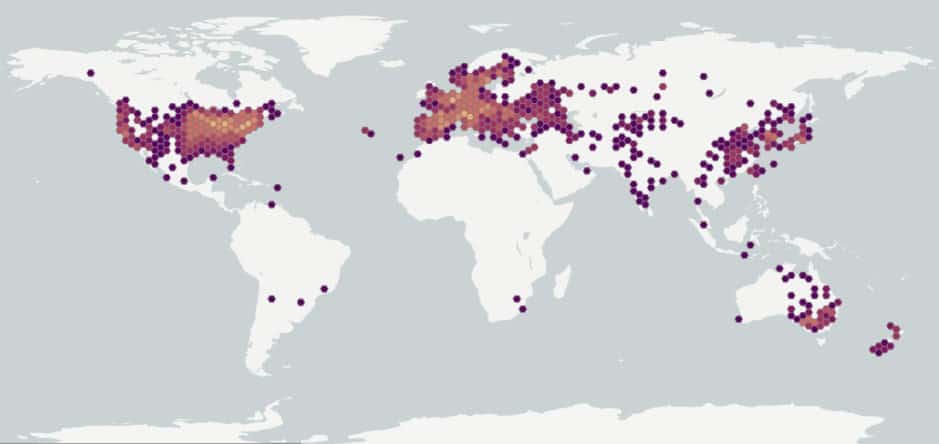Abutilon theophrasti
Overview
Aperçu
Regulation :
Remarques Réglementation:
- CFIA Weed Seeds Order - Class 2: Primary Noxious Weed Seeds
- USA Federal Noxious Weed Seed List
Regulation Notes:
Distribution :
Répartition :
Native to India or China and introduced to Asia, Europe, northern Africa, Australia and North America (Spencer 1984; CABI 2022,). The species is found throughout the United States, and is widespread in Illinois, Iowa, Indiana, Montana and California (CABI 2022). It occurs across Canada except in Newfoundland, Northwest Territories, Nunavut, and Yukon (Brouillet et al. 2010+). It is considered widespread in Ontario and Quebec (CABI 2022; Warwick and Black 1988). A. theophrasti is not yet found in Central or South America (CABI 2022).
Habitat and Crop Association :
Habitat et Cultures Associées :
The species grows in cultivated fields, field margins, fence rows, gardens, roadsides, vacant lots and other waste places. It is both cultivated for fiber and a major weed of Zea mays subsp. mays (corn), Glycine max (soybean), Sorghum bicolor (sorghum) and Gossypium hirsutum (cotton) crops (Warwick and Black 1988; CABI 2022).
Economic Use, cultivation area, and Weed Association :
Utilisation économique, zone de culture et association de mauvaises herbes :
Duration of Life Cycle :
Durée du cycle vital:
Annual
Dispersal Unit Type :
Type d’unité de dispersion :
Seed
General Information
RENSEIGNEMENTS GÉNÉRAUX
Abutilon theophrasti was historically used for fibre in China, and introduced into North America in the mid-1700s for this purpose (Spencer 1984; Warwick and Black 1988). Planting A. theophrasti for fibre in the United States is a likely source of invasions into other crops (Spencer 1984). Movement of feed grain is believed to have spread it throughout eastern Canada (Warwick and Black 1988). Each capsule produces 35-45 seeds, and with 70-199 capsules, a single plant can produce 700 – 17,000 seeds (Warwick and Black 1988). The seeds have a hard seed coat with microbial – inhibiting compounds and can remain viable for up to 50 years (Warwick and Black 1988).
.
Abutilon theophrasti infestation (Phil Westra, Colorado State University, Bugwood.org)
Identification
Identification
-
Capsule
Size
- Capsule length: 13.0 – 25.0 mm; width: 25.0 mm (Warwick and Black 1988)
Shape
- Capsule round, cup shaped in edge view
Surface Texture
- Capsule surface hairy
Colour
- Capsule colour is dark brown or black in the commonly encountered weedy plants (CABI 2022)
- Capsule of plants cultivated for fiber are light brown coloured (CABI 2022)
Other Features
- Capsule is made up of 12-15 fused segments, each opening along a seam to release the seeds at maturity (Warwick and Black 1988)
- Each segment on the capsule has a bristle at one end, also called a beak (Warwick and Black 1988)
-
Seed
Size
- Seed length*: 3.0 – 4.0 mm; width: 2.5 – 3.4 mm
*Note: minimum and maximum of 20 seeds in a normal range of this species using image measurement (ISMA 2020)
Shape
- Seed is heart-shaped with unequal-sized lobes and a V-shaped notch between them, compressed in edge view
Surface Texture
- Seed surface smooth, with scattered warty tubercles and short hairs
Colour
- Seed greyish brown, reddish brown, or brown
- Surface tubercles are yellowish- brown coloured with hairs
Other Features
Hilum and hilum area
- Hilum is in the notch between the 2 seed lobes, oval shaped with radiating grooves
- A flat piece of tissue generally covers the hilum, but may be removed during seed processing
- Surface tubercles become dense at the hilum end of the seed
Other than hilum
- A ridged reticulation with small interspaces can be seen under medium magnification

Velvetleaf (Abutilon theophrasti) seeds




-
Embryo
Size
- Embryo fills the seed
Shape
- Embryo is irregularly folded in the seed, axial position
Endosperm
- Endosperm is hard and translucent
Identification Tips
CONSEILS POUR L’IDENTIFICATION
Heart shaped or D-shaped seeds with the hilum in a notch is a common shape among species in the Malvaceae. The lobed shape, surface hairs and tuberculate surface texture of Hibiscus and other Abutilon species seeds can appear similar, but seeds are generally a smaller size with smaller lobes, and have different hair and tubercle surface patterns compared to those of A. theophrasti.

Velvetleaf (Abutilon theophrasti) seed




Additional Botany Information
AUTRES RENSEIGNEMENTS BOTANIQUES
Flowers/Inflorescence
- Five sepals and five yellow to yellowish orange petals each notched at apex (Warwick and Black 1988)
- Single flowers (or clusters) arise from the leaf axils and when open are 1.3 – 2.5 cm wide (Warwick and Black 1988)
Vegetative Features
- Erect stems are 1 – 2.5 m tall with velvety, heart-shaped leaves attached in an alternate fashion (Warwick and Black 1988)

Abutilon theophrasti flower (Rebekah D. Wallace, University of Georgia, Bugwood.org)




Similar Species
ESPÈCES SEMBLABLES
Similar species are based on a study of seed morphology of various species, and those with similar dispersal units are identified. The study is limited by physical specimen and literature availability at the time of examination, and possibly impacted by the subjectivity of the authors based on their knowledge and experience. Providing similar species information for seed identification is to make users aware of similarities that could possibly result in misidentification.
Hibiscus trionum L. (flower-of-an-hour)
H. trionum seeds (length*: 1.8 – 2.4 mm; width: 1.8 – 2.1 mm) are generally smaller than Abutilon theophrasti seeds with a dark brown colour, a surface with dense s warty tubercles consisting of brown hairs and resin glands, and lobes of a similar size. A. theophrasti seeds have fewer tubercles, the surface is light greyish-brown with unequal lobes compared to the similar species.
*Note: minimum and maximum of 10 seeds in a normal range of this species using image measurement (ISMA 2020)
Click to select species
Cliquez pour sélectionner les espèces

Hibiscus trionum
Comparison Window
Fenêtre de comparaison
MAIN SPECIES
ESPÈCES PRINCIPALES
Abutilon theophrasti

Abutilon theophrasti
Malvaceae
Velvetleaf (Abutilon theophrasti) seeds
MAIN SPECIES
ESPÈCES PRINCIPALES
Abutilon theophrasti

Abutilon theophrasti
Malvaceae
Velvetleaf (Abutilon theophrasti) seeds
MAIN SPECIES
ESPÈCES PRINCIPALES
Abutilon theophrasti

Abutilon theophrasti
Malvaceae
Velvetleaf (Abutilon theophrasti) seed
MAIN SPECIES
ESPÈCES PRINCIPALES
Abutilon theophrasti

Abutilon theophrasti
Malvaceae
Velvetleaf (Abutilon theophrasti) seed
SIMILAR SPECIES
ESPÈCES SEMBLABLES
Hibiscus trionum

Hibiscus trionum
Malvaceae
Flower-of-an-hour (Hibiscus trionum) seeds
SIMILAR SPECIES
ESPÈCES SEMBLABLES
Hibiscus trionum

Hibiscus trionum
Malvaceae
Flower-of-an-hour (Hibiscus trionum) seeds
SIMILAR SPECIES
ESPÈCES SEMBLABLES
Hibiscus trionum

Hibiscus trionum
Malvaceae
Flower-of-an-hour (Hibiscus trionum) seed
Need ID Help?
Besoin d’aide pour l’identification?
Reference(s)
Référence(s)
Brouillet, L., Coursol, F., Meades, S. J., Favreau, M., Anions, M., Bélisle, P. and Desmet, P. 2010+. VASCAN, the database of vascular plants of Canada. http://data.canadensys.net/vascan/ Accessed April 29, 2021.
Centre for Agriculture and Bioscience International (CABI). 2022. Invasive Species Compendium, CAB International, Wallingford, UK. https://www.cabidigitallibrary.org/journal/cabicompendium Accessed April 06, 2022.
Flora of North America (FNA) Editorial Committee, eds. 1993+. Flora of North America North of Mexico [Online]. 22+ vols. New York and Oxford. Accessed December 29, 2022
Global Biodiversity Information Facility (GBIF) Secretariat. 2022. https://doi.org/10.15468/39omei Accessed via https://www.gbif.org/species/3152614 Accessed December 29, 2022
Government of Canada (GC). 2016. Canadian Weed Seeds Order. https://laws-lois.justice.gc.ca/eng/regulations/SOR-2016-93/page-2.html (English) https://laws-lois.justice.gc.ca/fra/reglements/DORS-2016-93/page-2.html (French)
International Seed Morphology Association (ISMA). 2020. Method for Seed Size Measurement. Version 1.0. ISMA Publication Guide.
Spencer, N.R. 1984. Velvetleaf, Abutilon theophrasti (Malvaceae), History and Economic Impact in the United States. Economic Botany 38: 407-416.
Tropicos.org. 2022. Missouri Botanical Garden. https://tropicos.org Accessed April 06, 2022.
U.S. Department of Agriculture-Agricultural Research Services (USDA-ARS). 2022. Germplasm Resources Information Network (GRIN), https://npgsweb.ars-grin.gov/gringlobal/taxon/taxonomysimple.aspx Accessed April 06, 2022.
Warwick, S. I. and Black, L. D. 1988. The Biology of Canadian Weeds 90. Abutilon theophrasti. Canadian Journal of Plant Science 68 (4): 1069-1085.




